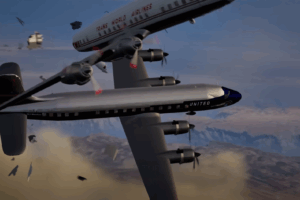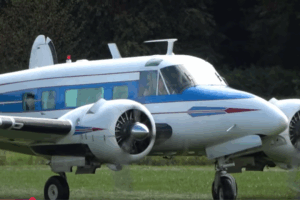The Martin M-130 is the airliner that gave Pan Am the true ability to span the world’s oceans.
Often called a “China Clipper” after the most famous of the three M-130’s built for Pan American, this aircraft introduced the modern era of long-distance international air travel. The M-130 provided scheduled commercial passenger service across the Pacific ocean from 1935 through World War II.

Martin M-130 Passenger Accommodations
The M-130 could carry 46 passengers in daytime configuration, but in its more typical overnight service it provided sleeping accommodations for up to 30 passengers in three 10-berth compartments (one forward and three aft), with a 16-seat dining room/lounge compartment located amidships.



Martin M-130 Technical Details
- Length: 90′ 10″
- Wingspan: 130′
- Empty Weight: 25,363 lbs
- Max Gross Takeoff Weight: 52,252 lbs
- Maximum passenger capacity: 41 (about 8 passengers between California and Hawaii)
- Engines: Four Pratt & Whitney R-1830 Twin Wasp radial engines; initially 830 hp, later 950 hp
- Propellers: Hamilton-Standard constant speed (variable pitch)
- Fuel capacity: 4,080 gallons
- Crew: 7
A noteworthy and innovative feature of the M-130’s design was the use of fuselage-mounted sponsons (or seawings) rather than the more typical wing-mounted floats or pontoons. Sponsons were an innovation by German aircraft builder Claude Dornier, who created a number of famous flying boats including the Wal and the DO-X. In addition to providing stability on the water, the wing-shaped sponsons provided aerodynamic lift in flight, kept spray off the tail surfaces during takeoff and landing, and carried 950 gallons of fuel each.
The Martin M-130 Fleet
Three M-130’s were built:
- NC-14714 – Hawaiian Clipper
- NC-14715 – Philippine Clipper
- NC-14716 – China Clipper
All three M-130’s were lost in accidents: The Hawaiian Clipper disappeared east of Manila under mysterious circumstances in July, 1938; the Philippine Clipper was flown into a mountain north of San Francisco in bad weather on January 21, 1943, killing its crew and a group of Navy officers including the Pacific submarine chief, Rear Admiral R.R. English; and the China Clipper itself sank at Port of Spain, Trinidad, on January 8, 1945.
Development and History of the Martin M-130 Clipper
Even before the first Sikorsky S-40 entered service in 1931, it was obvious that the plane — which Charles Lindbergh called a flying forest — would not provide the performance necessary to fulfill Pan Am’s ambitions, and the airline began searching a streamlined airliner that could truly span the oceans. Two manufacturers wanted the job; Igor Sikorsky wanted a chance to improve on his own S-40, and Glenn Martin wanted to establish his company in the commercial aviation business. Juan Trippe ordered planes from both.

The driving force behind Pan Am’s specifications for a new plane was Andre Priester, the Dutch immigrant who had worked for KLM and who became Pan Am’s detail-obsessed chief engineer. Charles Lindbergh, who had been so deeply involved with Pan Am’s earlier designs, had just undergone the trauma of his son’s kidnapping and murder on March 1, 1932, and was only minimally involved with the plans for the new clipper.
Pan Am wanted a plane that could fly 3,000 miles (long enough to reach Europe or Hawaii) while carrying a payload equal to its own weight, and the Glenn L. Martin Aircraft Company designed a plane that met the airline’s needs. Although the first Martin M-130 was delivered over a year behind schedule, and its $417,200 cost was almost twice that of the Sikorsky S-42 (and more than five times the $78,000 price of the leading airliner of the day, the Douglas DC-2), the M-130 had the speed, size, and range to carry mail and passengers profitably across the Pacific or Atlantic.
The first M-130, named China Clipper, was delivered to Pan American on October 9, 1935, just two days after its first test flight. A little more than a month later, on November 22, 1935, China Clipper left San Francisco on the first scheduled mail flight across the Pacific ocean.

Pan Am took delivery of a second M-130, named Philippine Clipper, on November 14, 1935, and a third and final M-130, the Hawaiian Clipper, on March 3, 1930. To the great disappointment of Glenn Martin, no additional M-130’s were ordered by Pan Am, and Martin suffered a significant financial loss from selling only three copies of the revolutionary aircraft his company had developed.
The M-130 became firmly associated with Pan Am’s pioneering conquest of the Pacific ocean, and the name “China Clipper” became famous around the world. Unfortunately, the plane’s performance, although far greater than that of any previous aircraft, posed a challenge for profitable passenger operations; the fuel load required to reach Hawaii from California prevented Pan Am from carrying more than about eight passengers on that leg, which was the lynch pin of the airline’s Pacific service. And while far more comfortable than any other long-distance airliner before the introduction of the Boeing B-314, and offering speed which greatly out-paced crossing the Pacific by ship, the M-130 was still considered somewhat noisy and cramped for long distance flights, and it was eventually replaced by the larger and more comfortable B-314.




